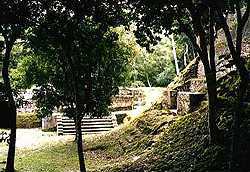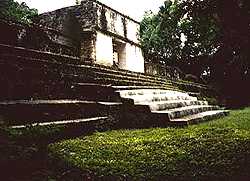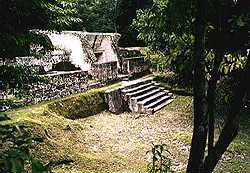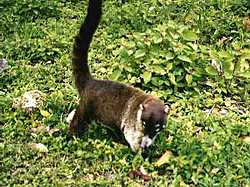I stayed at a small ranch hotel called Clarissa Falls, in a Mayan hut with bath, and watched
and admired the many birds Minta kept at the main house, as well as 200 or so head of long-horn
cattle that shared the meadow outside the window of my hut, as well as assorted dogs, cats,
goats, geese, many chickens and a beautiful Toucan named Romeo.
The owners of the ranch were kind enough to let me leave my rental car here for a few days,
while I took a bustrip into Guatemala and Tikal, because you can not take a rental car across
the border.

Cahal Pech means 'place of ticks', although the site is not really infested by many pests.
There are 34 major structures, grouped around several courtyards and plazas. A large group of
Formative Period figurines, from about 1000 BC-250 AD have been found at the site, some of
them in the form of ocarinas or whistles.
The Main Plaza is surrounded by temple platforms, one of which is built into the natural
hillside of the site to create a pyramid. This view is looking into the east courtyartd,
with the stepped terraces of the main pyramid ascending toward the right side.

Cahal Pech is an earlier, Pre-Classic Mayan site, and it is of somewhat cruder construction. The buildings are grouped around a main plaza and several subsidiary courtyards lined with steps and terraces, they form shallow palace structures with doorways facing into the plazas. The interiors of the buildings are typically lined with benches along the rear wall.

Mayan construction technology was relatively crude and simple, most of the palace structures are made of parallel walls spanned by corbelled vaults, creating long, shallow interior spaces, accessed by multiple doorways along the sides of the courtyard. The tops of the vaults are locked into place with a counter-weight, creating the typical crowning roofcomb.

The courtyard of the East Palace complex is accessed by a large corbelled Mayan Archway. Inside this is a smaller courtyard surrounded on three sides by long, vaulted buildings with open arcades. A free standing wall and the Arch close off the courtyard on the south side.

These can be found in groups at many of the archaeological sites in the area. They're pretty tame and they'll climb all over you for food; they have even been known to attack some of the weaker tourists when they get real hungry.
